Product Images Gemcitabine Hydrochloride
View Photos of Packaging, Labels & Appearance
- gemcitabine-carton-label-1-g - gemcitabine carton label 1 g
- gemcitabine-carton-label-200-mg - gemcitabine carton label 200 mg
- gemcitabine-vial-label-1-g - gemcitabine vial label 1 g
- gemcitabine-vial-label-200-mg - gemcitabine vial label 200 mg
- fig1 - image1
- fig2 - image2
- fig3 - image3
- fig4 - image4
- image5 - image5
Product Label Images
The following 9 images provide visual information about the product associated with Gemcitabine Hydrochloride NDC 68083-148 by Gland Pharma Limited, such as packaging, labeling, and the appearance of the drug itself. This resource could be helpful for medical professionals, pharmacists, and patients seeking to verify medication information and ensure they have the correct product.
gemcitabine-carton-label-1-g - gemcitabine carton label 1 g
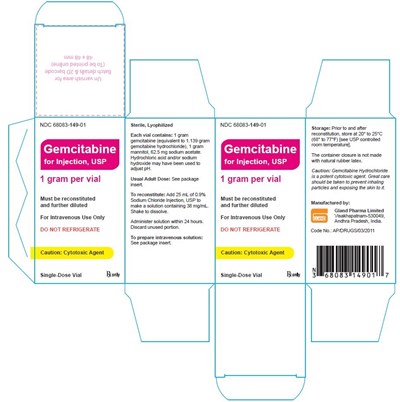
Gemcitabine is a cytotoxic agent that is available in a single-dose vial containing 1 gram of sterile, lyophilized powder. The vial must be reconstituted and diluted before intravenous use. The usual adult dose is specified in the package insert. The powder should be stored at 20-25°C and should not be refrigerated. Great care should be taken to prevent inhaling particles or exposing the skin to it. The manufacturer is Gland Pharma Limited based in India. NDC 68083-149-01.*
gemcitabine-carton-label-200-mg - gemcitabine carton label 200 mg
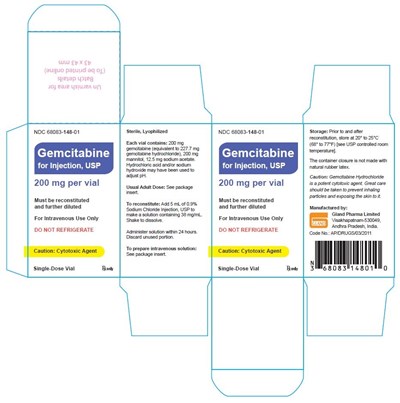
This is information about Gemcitabine, available in a single-dose vial containing 200mg of the drug, which must be reconstituted and diluted before administering intravenously within 24 hours. The drug should not be refrigerated and is a cytotoxic agent that requires careful handling to prevent inhalation or exposure to the skin. The vial contains 200mg of gemcitabine, 200mg mannitol, and 12.5mg sodium acetate. The usual adult dose details are provided in the package insert. The container closure is not made with natural rubber latex. The drug is made by Gland Pharma Limited in Visakhapatnam, India. Storage temperature requirements and code numbers are also provided.*
gemcitabine-vial-label-1-g - gemcitabine vial label 1 g
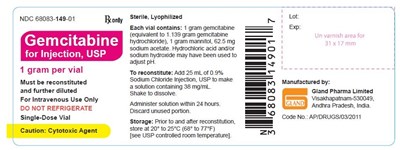
Beonly Gemcitabine for Injection, USP is a cytotoxic agent that comes in a sterile, lyophilized form in a 1 gram per vial. The vial must be reconstituted and further diluted with 0.9% Sodium Chioride Injection, USP to make a solution containing 38 mg/mL. This solution is for intravenous use only, and must not be refrigerated. Each vial contains 1 gram gemcitabine (equivalent to 1.139 gram gemcitabine hydrochoride), 1 gram mannitol, 62.5 mg sodium acetate. Hydrochloric acid and/or sodium hydroxide may have been used to adjust pH. Discard any unused portion and store the solution at 20° to 25°C (68° to 77°F) [see USP controlled room temperature]. NDC 68083-149-01 is manufactured by E Gland Pharma Limited in Andnra Pradesh, India.*
gemcitabine-vial-label-200-mg - gemcitabine vial label 200 mg
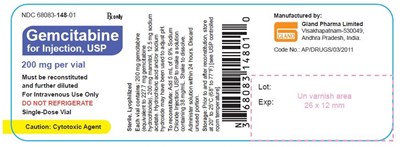
This is a product label of Gemcitabine for injection, USP manufactured by Gland Pharma Limited in Andhra Pradesh, India with a code number of AP/DRUGS/03/2011. Each vial contains 200 mg of Gemcitabine powder, which requires reconstitution and further dilution before intravenous use. The label warns not to refrigerate and states that it is a cytotoxic agent.*
fig2 - image2
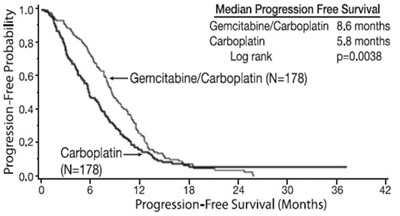
The text seems to be a part of a research study or clinical trial, comparing the efficacy of two treatments for cancer (Gemcitabine/Carboplatin and Carboplatin) in terms of progression-free survival. It gives the median progression-free survival of both treatments in months and mentions a log-rank p-value, indicating statistical significance. The text is not complete or clear enough to provide further information.*
fig3 - image3
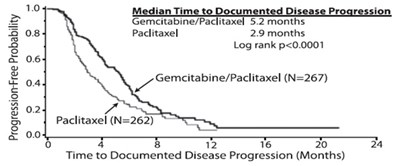
This is a comparison of the efficacy of two drugs, Gemcitabine/Paclitaxel and Paclitaxel, in treating a documented disease progression. The study is based on a sample of 267 patients using Gemcitabine/Paclitaxel and 262 patients treated with Paclitaxel. The data suggests that patients treated with Gemcitabine/Paclitaxel had a longer time to documented disease progression of 5.2 months compared to Paclitaxel which was only 2.9 months. The log rank p-value was less than 0.0001, indicating that the difference in efficacy between the two drugs was significant.*
* The product label images have been analyzed using a combination of traditional computing and machine learning techniques. It should be noted that the descriptions provided may not be entirely accurate as they are experimental in nature. Use the information in this page at your own discretion and risk.


